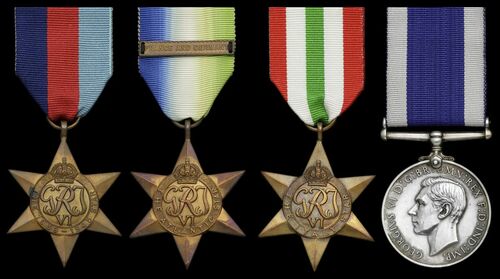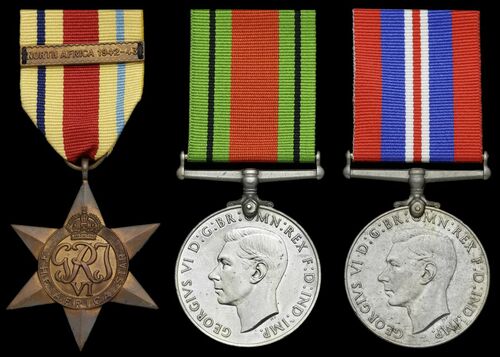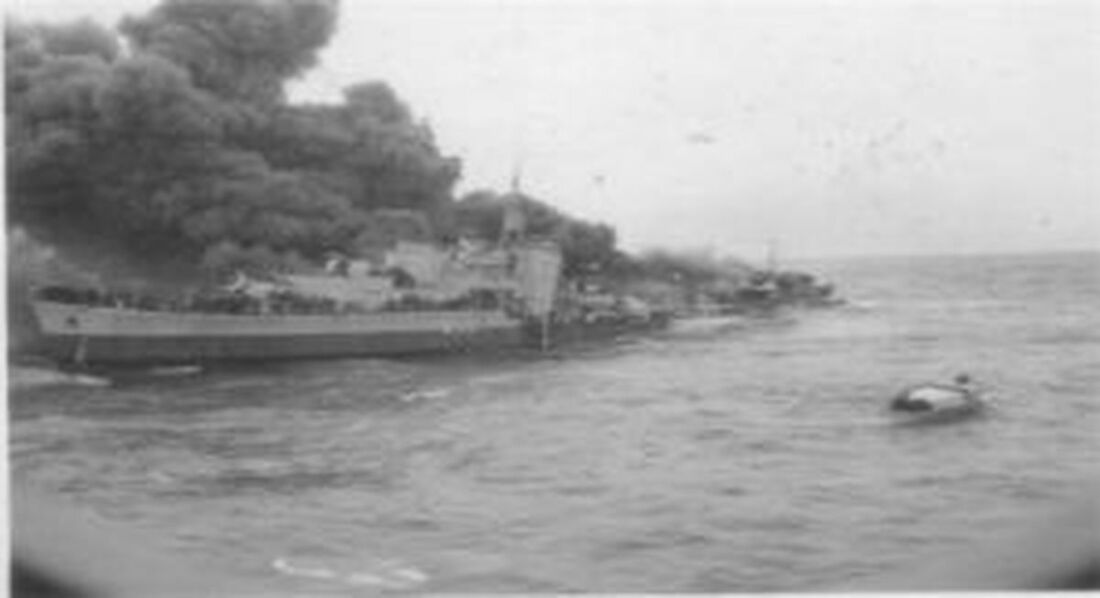Auction: 23001 - Orders, Decorations and Medals
Lot: 201
Seven: Stoker Petty Officer L. A. Taylor, Royal Navy, who was twice sunk during the Second World War and who also served on the Arctic Convoys
1939-45 Star; Atlantic Star, clasp, France and Germany; Africa Star, clasp, North Africa 1942-43; Italy Star; Defence and War Medals 1939-45; Royal Navy L.S. & G.C., G.VI.R., 1st issue (K.6707 L. A. Taylor. S.P.O. H.M.S. Gloucester.), good very fine (7)
Leonard Arthur Taylor was born at Loughborough on 11 August 1907 and entered the Royal Navy as a Stoker 2nd Class in March 1925. He earned his L.S. & G.C. Medal in March 1940 and was soonafter transferred to the Venetia.
Boulogne
On 23 May 1940, Venetia and the destroyers Vimiera, Whitshed, Venomous, and Wild Swan arrived off Boulogne, France, to evacuate troops of the British Army's Irish Guards and Welsh Guards, who had been trapped there by advancing German troops and tanks of the 2nd Panzer Division during the Battle of Boulogne. Sixty German Junkers Ju 87 Stuka dive bombers had recently attacked the harbour and French destroyers bombarding offshore, so they awaited the arrival of Royal Air Force fighter cover before attempting to enter the harbour. After it arrived at 19:20 hours, Whitshed and Vimiera entered the harbour first, taking aboard as many British soldiers as possible – over 550 men each – under fire from German forces before steaming back out of the harbour at 20:25 hours, with Whitshed completely destroying two German tanks at point-blank range with her 4.7-inch (120-mm) guns as she departed.
Venomous and Wild Swan entered the harbour next, at 20:35 hours, followed by Venetia at 20:40 hours. The Germans opened fire on Venetia with heavier guns as she entered the harbour, apparently in an attempt to sink her in the harbour entrance to trap Venomous and Wild Swan and bring the evacuation operation to an end. A German shell, probably from a tank, hit Venetia, starting a fire aft and prompting her crew to jettison her torpedoes and burning Carley floats. Another shell hit her "B" gun turret, blowing overboard and killing some of the men there, and German gunfire also inflicted casualties among the men on her bridge, causing her to go out of control and briefly run aground. Gunners aboard Venomous, seeing that Venetia was in danger of being sunk, realized that the Germans had captured Fort de la Crèche on a hill overlooking the entrance and were using its coastal artillery to fire on Venetia. Venomous opened fire on the fort; her first salvo went over it, but her second salvo blew off one side of the fort and much of the hillside it was on, causing artillery pieces to roll down the hill and silencing the fort. Venomous also detected a German light field gun in the garden of a house and fired on it; her first salvo flattened all of the trees in the garden, set the house on fire, and caused German troops in the vicinity to flee. All heavy German guns fell silent after this and, given a reprieve, Venetia, which had taken seven hits and been unable to embark any troops, quickly refloated herself and backed out of the harbour at full speed at 20:48 hours. Venomous and Wild Swan followed Venetia out of the harbour, also in reverse, carrying about 400 evacuees each, along the way knocking out a German tank and shooting up two German troop columns, then escorted the damaged Venetia to Dover. A congratulatory message from the Vice-Admiral Destroyers, Dover, dated 24 May 1940, was read to recipients including the ship's company of Venetia:
'I wish to express my admiration of the manner in which the Destroyers attached to the Dover Command carried out the difficult operation of evacuating the troops from Boulogne both in the face of heavy air attack and point-blank fire from guns, machine-guns and snipers. The handling of their ships and their armaments and the bearing of the ships' companies was beyond all praise. The following received from the CIGS [Chief of the Imperial General Staff] - Army's thanks to your people for last night's magnificent effort at Boulogne.'
In the drink
After spending the summer of 1940 undergoing repairs, Venetia returned to Nore Command in August 1940 and began convoy defence and patrol duties in the North Sea and Thames Estuary in September 1940. On 19 October 1940, she struck a mine off Knob Buoy in the Thames Estuary some 12 nautical miles northwest of Margate and sank. Thankfully Taylor was taken aboard the Walpole
Take two - sinking feeling
Taylor joined the destroyer Gurkha and he remained similarly employed up until her loss in January 1942. Laid down in 1938, Gurkha was to have been named Larne, but on the loss of her namesake in 1940, the Gurkha Brigade offered to pay for a new ship. In gratitude, the Prime Minister, Winston Churchill, ordered that the destroyer to be launched should be named Gurkha; the launching ceremony was performed by his daughter Mary, and the ship was completed on 18 February 1941.
At the end of July 1941, after working up at Scapa, Gurkha formed part of an anti-submarine escort to a Middle East troop convoy to Suez. On 29 August she was ordered to join the escort of convoy OC-71 which had suffered severe losses and, on her arrival at Gibraltar, she came under the orders of the Flag Officer Force H.
Early in the morning of the 30 September 1941, while acting as anti-submarine screen to Force H, she destroyed the Italian submarine Adua east of Cartanga. Later in the year she escorted Nelson home after she had been torpedoed in a Malta convoy whilst giving passage to the Ark Royal survivors. A very sudden storm caused Gurkha serious damage and she made for Plymouth for repairs.
Back in Gibraltar by mid-December 1941, Gurkha returned to escort duties. On 16 January 1942, she left Alexandra escorting convoy MW-8B and during the night she took the astern position. At first light, while proceeding at 25 knots to take up a new station, she was hit by a torpedo from U-133 and her aft magazine blew up.
Amidst dramatic scenes - she was ablaze from bow to stern - the stricken Gurkha was towed clear of burning surface oil by the Dutch destroyer Isaac Sweers, thus saving the greater part of her crew. The survivors were transferred to the Dutch destroyer by boats and later landed at Tobruk; Taylor was among them.
Convoy duty
After further postings to Derby and Sphinx, Taylor joined Offa on 26 January 1944, the same day she picked up survivors from the British merchantman Fort Bellingham that was sunk by a torpedo from U-957 in the Barents Sea. He would share in a series of Arctic Convoy runs and would be entitled to the Arctic Star. Put ashore in May 1947, Taylor sadly took his own life on 28 February 1979; sold together with copied service details.
Subject to 20% VAT on Buyer’s Premium. For more information please view Terms and Conditions for Buyers.
Sold for
£250
Starting price
£170











